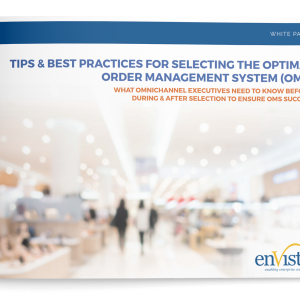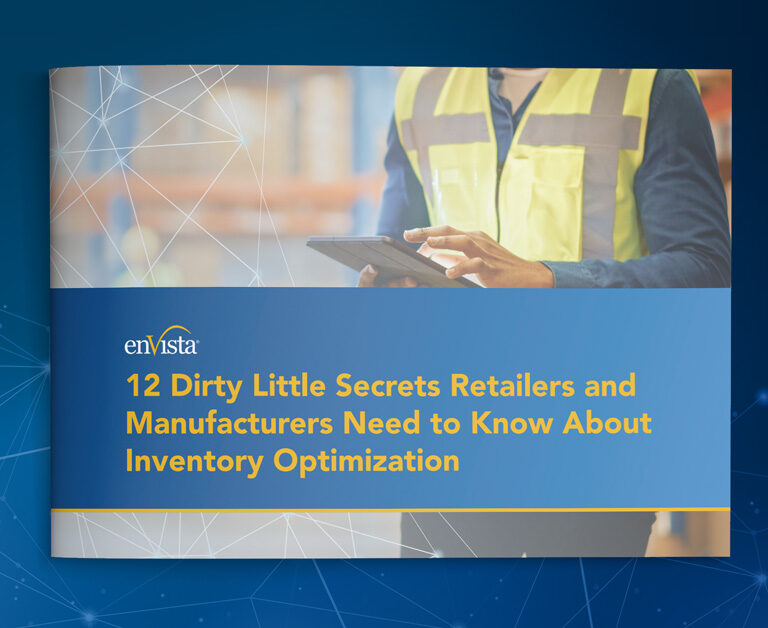Shifting consumer buying habits and values are forcing retailers to rethink their fulfillment strategies to remain competitive. As commerce becomes more complex, retailers increasingly need a foundation of integrated, robust technology. A functionally rich order management system (OMS) is key to unifying commerce and delivering seamless customer experiences.
This article explains everything retailers need to know about what an OMS is and why they need one.
Table of Contents:
- What is an Order Management System (OMS)?
- Order Management Features vs. OMS
- Why an OMS is a Must-Have for Retailers
- What Type of Retailers Need an OMS?
- Where an OMS Fits in the Technology Stack
- What Are the Benefits of an Order Management System?
- The Four Pillars of OMS:
- Must Have Features for an Order Management System
- How enVista Can Help
What is an Order Management System (OMS)?
An order management system is a technology platform that coordinates all the essential functions of a purchase, spanning the entire buying journey from browsing to buying and un-boxing. These centralized platforms facilitate and communicate all the details associated with an order such as:
- Where is the inventory currently?
- Where was the order placed?
- Where/how should the order be fulfilled?
- What machine learning or artificial intelligence do we have that can optimize the fulfillment process?
- Who (people) and what (systems) need communication alerts throughout the order lifecycle?
An order management system is the core commerce technology unifying customer-facing channels with back-end business technology systems and helping retailers keep the customer at the center of a brand’s experience.
Order Management Features vs. OMS
Order management has become a much more common term in commerce in the last few years. In fact, in The Gartner 2024 Market Guide for Distributed Order Management (DOM) Systems, analysts said, “In the past three years, Gartner has seen an increased interest from, and investment in, DOM systems from B2B companies for order orchestration.”
It’s essential to understand the difference between an order management system and standalone order software. OMS is a full-function order management platform that lets companies manage the complete cycle of an order from order placement to final fulfilment. This channel-agnostic system accepts orders from online platforms and brick-and-mortar shops.
OMS platforms determine inventory before accepting the order, validate payments and coordinate order fulfillment and delivery. They also provide a single source of information and facilitate customer service, exception management and exchanges.
Standalone order software is a tool that accepts and processes orders. However, it doesn’t provide additional services, such as inventory checks, order fulfillment and customer service.
While many technology platforms offer light order management capabilities, for the sake of this article, we are primarily discussing dedicated, built-for-purpose OMS platforms focused on unifying the buying process for consumers and retailers alike.
Why an OMS is a Must-Have for Retailers
When it comes to the customer experience, perception is reality. Forbes reports that 64 percent of customers switch brands if they don’t receive good customer service. Customers expect a consistent experience from their interaction with all channels across an organization. For mid-market retailers, this means you need an OMS solution that works — the cost of not getting the customer experience right is a risk that has a compounding negative impact.
An OMS Builds Trust in Your Brand
When a customer purchases from a retailer or a brand, they indicate some level of trust with the retailer. The brand must deliver on their promises to maintain that trust.
A positive customer experience often results in repeat purchases, brand loyalty and potentially brand advocacy. A negative experience, as research confirms, results in brand swapping, negative reviews and potentially a lifelong brand detractor.
The right order management system helps curate the best customer experience in the most cost-effective way to earn and maintain the trust of your buyers, turning them into loyal brand advocates.
What Type of Retailers Need an OMS?
The need for an order management system directly correlates with a brand’s operational and fulfillment complexity. The more complex your supply chain management process, the more an OMS can help. Several parameters drive the complexity of fulfillment operations – including inventory sources, fulfillment nodes, omnichannel requirements, third-party fulfillment providers, system integrations, product offerings and more.
While a local mom-and-pop store may not require a robust OMS, a mid-market or enterprise retailer with multiple channels and fulfillment nodes would quickly recognize the return on investment (ROI) from the right order management software.
Where an OMS Fits in the Technology Stack
An OMS is the technology bridge that unifies customer-facing systems to back-end business/operational systems. Since order management systems are also the core of your customer care processes, it is the first line of defense for your customer service agents – highlighting the need for real-time information and accuracy to empower your team to provide the highest level of service.
For brands and retailers with brick-and-mortar stores, an order management software should have an intuitively operable store app that enables associates to view store inventory levels, see all order history and fulfill orders – whether ship from store or buy online pick up in store (BOPIS).
What Are the Benefits of an Order Management System?
- Tighter control of your customer experience — Take control of the order management process to curate the exact brand experience you want customers to have, including omnichannel capavilities, inventory visibility, customer-initiated returns/exchanges, etc. An OMS almost always leads to an increase in customer satisfaction.
- Higher margins & less waste — With the ability to fulfill orders more efficiently across your network and sales channels, you can eliminate unnecessary costs associated with excess inventory levels, suboptimal processes and operational waste.
- Better business decision making — Leverage built-in key features such as business intelligence, machine learning and artificial intelligence to prevent human errors, forecast more accurately, fulfill more efficiently and service customers more strategically.
- Improved visibility — You can’t fix what you can’t see. Aggregate all item, customer, payment, inventory, order and fulfillment information across channels and systems.
- More agility to meet customer expectations — Take advantage of plug-and-play integrations with key providers and utilize integration-platform-as-a-service (iPaaS) to use the fullest extent of all your systems, together.
The Four Pillars of OMS:
Let’s take a look at the four pillars of an OMS.
Inventory Visibility
Inventory is often the largest capital expenditure for retailers, and poor inventory management can wreak havoc on a company’s bottom line. But while inventory management is a critical aspect of the business, many retailers only achieve an average of 60-65% inventory accuracy. This means that when a customer buys something online, there is a significant chance it won’t be in stock.
Inventory visibility is crucial for retailers. It reduces holding costs, prevents loss sales from stockouts and avoids price markdowns from overstocks. Ultimately, an efficient OMS streamlines inventory control.
Order Orchestration
Order orchestration is the rules and routing of an order that indicates how and where an order is fulfilled. The algorithms and rules engine establishes where the inventory is located and the optimal location to fulfill the order based on business requirements like fastest to customer, avoiding split shipments, ship a specific SKU from vendor, etc.
The order orchestration functionality of an effective OMS ensures that the fulfillment logic is consistent with available stock levels and fulfillment capacity. This can be supplemented by business intelligence driven by machine learning to deliver the right product, at the right time, at the right cost.
Omnichannel Fulfillment
Historically, retail has operated in a single-channel format. Consumers would engage or purchase from a simple sales channel like a physical store, or online order.
Omnichannel commerce is the correlation of multiple channels working together to influence consumers. It’s more convenient for consumers and benefits retailers. Data suggests that omnichannel grocery shoppers spend an average of 50 percent more than single-channel brick-and-mortar-only shoppers. Omnichannel commerce fulfillment enables brands and retailers to process, source and finalize an order from multiple channels within their network.
Examples of omnichannel fulfillment include shipping from store, BOPIS, curbside pickup, ship to locker and vendor dropship. True omnichannel fulfillment enables consumers to buy or return an order through any channel, such as buying online and returning in-store (BORIS). Tracking and fulfilling orders with speed and accuracy is key to successful omnichannel fulfillment.
| Buying Channels | Fulfillment Channels | Customer-Care Channels | Return Channels |
| Stores Ecommerce site Marketplaces | Owned warehouse 3PL Vendor dropship Marketplaces (FBA) Stores / Dark stores | Online Live Chat Stores Phone Support | Stores Mail to warehouse Digital returns Return drop-off locations/lockers |
Customer Care
The customer care portal is where customer service representatives have a 360-degree view of the shopper. It allows agents to modify orders and order details, process discounts, manage appeasements and process returns and refunds. The key criteria of a customer care center are to have the visibility and information to service customer needs and expectations quickly.
Poor customer service is costly. The New Jersey Business and Industry Association reports that just one bad customer service experience has a more than 50 percent chance of a lost customer.
Increased customer satisfaction is one of the biggest benefits of an OMS.
Must Have Features for an Order Management System
There are many OMS solutions on the market. You want to choose an OMS with the following features:
Real-time Cross-Channel Inventory and Order Visibility. Full integration across all channels with real-time inventory visibility and order assignment capabilities can prevent overselling.
Intelligent Order Routing. This allows you to route orders to the most convenient fulfillment location, minimize delivery time and reduce shipping costs.
Flexible Cross-Channel Returns Management. A built-in returns solution allows customers to efficiently return goods to any location (even when bought online).
Integration-First Approach. With the pace of commerce, the foundation for an order management system is crucial to long-term viability. A valuable OMS will be ready-to-integrate with your commerce channels, WMS, ERP system, etc.
Microservices Architecture. Retail is not one size fits all, nor should your technology stack be. Microservices architecture allows retailers to select the functionality that makes the most sense for their strategic plan and weave in additional modules as needed.
Broad Understanding of Supply Chain & Commerce. There are many tools that can offer order management capabilities. However, selecting an order management system built by experts who understand supply chain management is a huge competitive advantage for retailers and brands.
How enVista Can Help
With more than 20 years of experience in supply chain and enterprise technology, enVista is uniquely placed to help you find the OMS solution that best suits your business’s needs. We have helped hundreds of retailers select and implement the right OMS for their businesses, cultivating operational excellence across every industry and vertical. Ready to master the order management process and make your OMS a competitive differentiator? Let’s have a conversation. ™

Tips and Best Practices for Selecting the Optimal Order Management System (OMS)
An OMS is necessary for omnichannel success. Following the proper steps can ensure a successful system selection and partnership.







